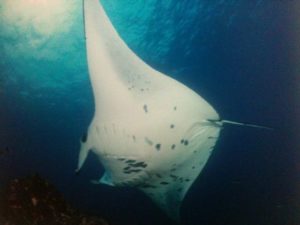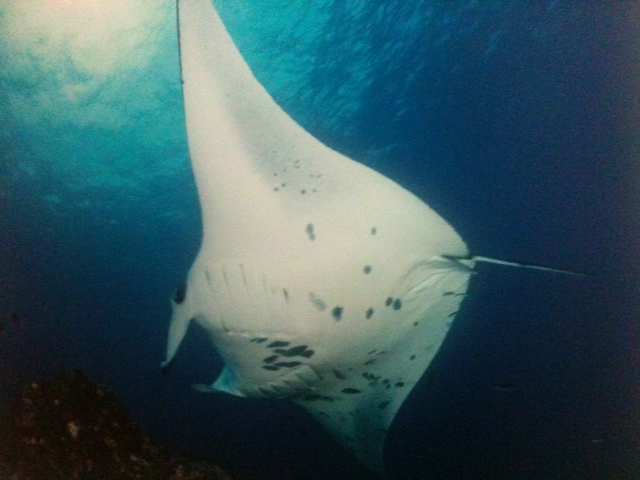A Study of Melanism in the Black Manta Rays of the Indo-Pacific
by Steve Reynolds
Melanism is “darkening of body tissues caused by excessive production of melanin, especially as a form of colour variation in animals”.
I know that black manta rays in the Indo-Pacific does not relate to South Australian marine life at all, but I read a report about a study of melanism in the Black Manta Rays of the Indo-Pacific recently in order to continue my 40-year interest in fish colouration. I hope that, by reporting details of the study, the findings may be applied to South Australian species in some way.
Here is a photo of a ‘normal’ manta ray with a white underside: –

According to Scientists Explore the Occurrence of Black Manta Rays in the Indo-Pacific scientists from the Marine Megafauna Foundation (MMF), University of Western Australia, University of Papua, Udayana University, Murdoch University, and Macquarie University set out to learn more about the colour variation of black manta rays in the Indo-Pacific. It was the first study to investigate melanism in a marine species.
Some video footage can be seen at https://www.youtube.com/watch?v=eLcBwYUH7UI
Melanism is said to occur when an increase in darker pigments in an animal’s skin (or fur) results in darker-coloured, or entirely black, individuals.
The scientists’ research found that “the frequency of melanism varied across the studied locations, and that this variation was more likely a result of random evolutionary processes such as genetic drift, as opposed to selection by predation”.
Melanism is rare in marine species. The most prolific example of melanism in the ocean occurs in manta rays. Darker-coloured or entirely black individuals are often mistaken as a different species, but these melanistic individuals are said to be simply a different colour variation (or ‘colour morph’) within a species.
As stated above, the most prolific example of melanism in the ocean occurs in manta rays. This is said to be “particularly unusual as manta rays are the only shark or ray known to exhibit melanism, especially in such high proportions. While typical manta rays are dark grey on their backs and mostly white on their undersides, melanistic (or black) mantas are completely black on their backs and almost entirely black on their underside with a central white blaze that varies in size and shape, and can be used to identify individuals”.
Melanism was found to be “most prominent in the Raja Ampat (West Papua, Indonesia) population of reef manta rays”.
“Researchers made use of MantaMatcher – a global database for manta rays where scientists and members of the public record encounters – to access identification photos of individuals from a range of locations.”
“The study used long-term manta ray photo identification catalogues to investigate melanism in giant and reef manta rays across a number of locations in the Indian and Pacific Ocean. Researchers found that black mantas were common in some locations, making up 40% of some populations. Strangely, they were completely absent in others.”
Lead author, Stephanie Venables said, “Melanism was most prominent in the Raja Ampat (West Papua, Indonesia) population of reef manta rays (40%) and in the Ecuador population of giant manta rays (16%), which is interesting considering the distance between these two regions. The variation in melanism frequency across locations raises the questions of why melanism has persisted in manta rays, and why it is more common in some populations than others.”
“In some terrestrial species, melanism has been linked to improved camouflage or increased thermoregulation. But scientists questioned whether it could have any benefits or disadvantages to manta rays. While black manta rays may look stealthy to us, their darker colouration could, in fact, make them more visible to predators. To begin to answer this question, the study also looked at whether survival rates were different for melanistic mantas when compared to typical-coloured manta rays.”
Dr Andrea Marshall, co-founder and principal scientist of MMF’s global manta ray program said, “Because of their size, manta rays don’t have many predators, mainly larger sharks and orcas. Despite being less camouflaged, we found that predators don’t appear to target black mantas more than normal coloured mantas, as survival rates were equal”.
“The findings suggest that predation does not influence melanism in these populations. It is likely that the variation in melanism percentages across locations may be a result of more random evolutionary processes such as genetic drift, where traits occur in a population by pure chance. The study also found evidence that melanism may spread between neighbouring populations through gene flow in giant manta rays, which occurs when individuals travel between locations.”
It was suggested that “while black manta rays may look stealthy to us, their darker colouration could, in fact, make them more visible to predators”.
As stated earlier, researchers made use of MantaMatcher – a global database for manta rays where scientists and members of the public record encounters – to access identification photos of individuals from a range of locations. “This study also highlights the benefits of long-term photo-ID catalogues and collaborative citizen science platforms like MantaMatcher, which enables research of this kind to take place,” said Dr. Marshall.
“Melanism is typically a heritable trait that is passed down from generation to generation, yet scientists are still trying to identify the genes that are responsible for melanism in manta rays.”
Lead author, Stephanie Venables concluded, “Understanding melanism can give us insight into how global manta ray populations are connected, and how certain traits spread across different locations. We are only just beginning to understand melanism in manta rays and we hope that future research will reveal more about this fascinating trait.”
The study. titled “It’s not all black and white: investigating colour polymorphism in manta rays across Indo-Pacific populations” (by Venables et al) was published in the journal Proceedings of the Royal Society B on 9th October 2019 and is available at http://rspb.royalsocietypublishing.org/lookup/doi/10.1098/rspb.2019.1879 .


Interesting ,Steve. Like most good science papers it raises more questions than it answers .Just thinking about one aspect ,the preliminary results suggesting that mantas with melanism don’t suffer increased predation, I would question the basis of a few assumptions the researchers appear to have made. Firstly ,they say that it’s likely that all-black mantas are less camouflaged .While that would be valid in the historically clear water of their usual habitats, the opposite may apply for mantas inhabiting more turbid less clear water ,and we know that visibility and light penetration are deteriorating in many shelf waters especially close to shore where large rivers enter the sea.
Of course I have no knowledge of the extent of rising turbidity in the two places studied( parts of Ecuador and Indonesia) compared with all the other places frequented by mantas, but I wouldn’t accept that any interpretation is possible until this potential confounding factor is excluded.
The researchers, in my opinion ,therefore have no sound basis for concluding that the likely basis for those two ‘hotspots ‘ of manta melanism is random gene drift ,or whatever was the terminology used.
I think it is quite likely to be an evolved consequence of declining water clarity, which in turn is obviously anthropogenic ,due rapidly growing human populations in coastal areas globally,and I am guessing that Ecuador and many parts of Indonesia would be up there among the worst affected ,particularly as the catchment rainfall is high in both cases.
Enough for now:)
And I don’t need to remind you Steve about the earlier MLSSA articles we collaborated on, about the unusual black Zebrafish occurring in places like Lady Bay after a series of very wet winters .
Thanks for all your thoughts and comments David. I had thought about use of your black-faced zebra fish photo for this